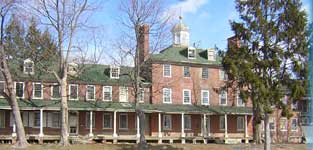| 1000 AD | Native American, Lenni-Lenape, inhabitance |
| 1643 | New Swedish Colony formed- 1st European settlement in Pennsylvania and included first government office (Printzhof) plus church, school and residences (population 250)
|
| 1655 | Dutch Settlement |
| 1664 | English Settlement |
| 1681 | Duke of York gave William Penn a deed to land located on the west side of the Delaware River, including what is now Delaware County, in gratitude for assistance given to the crown by the Penn family. |
| 1742 | First Quarantine Station for City of Philadelphia built at mouth of Schuylkill River.- Outbreaks of epidemics throughout the colonies (ex. Smallpox killed 95% of Indians in Connecticut and 1,000 Iroquois in New York, Yellow Fever in Charleston 1699 killed 190, and 5% in 1709)
|
| 1793 | Yellow fever epidemic in Philadelphia — 4-5,000 residents die (about 10% of population) and 17,000 left the city |
| 1798 | Board of Health formed to combat epidemics.- Created by the state with the power to levy taxes, but controlled by Philadelphia
- Marine City Hospital Group purchased 10 acres in Tinicum from Tom Smith
|
| 1799-1800 | The Lazaretto built |
| 1802 | Yellow fever epidemic in Philadelphia |
| 1804 | John Ferguson on schooner "Monongohela Farmer" allowed 32 passengers |
| 1820 | Yellow fever epidemic in Philadelphia |
| 1824 | Oyster boat landed in Chester and man ill with smallpox brought to Lazaretto and caused outrage among citizens (sick being carried overland to hospital) |
| 1832 | Cholera epidemic |
| 1870 | Brig "Home" from Jamaica was quarantined because of death of Captain. Logwood (4 days before). Cargo was taken to shore for fumigation and woman & child on board tug died of yellow fever. Eventually, the physician, nurse and quarantine master died among the twenty who contacted disease. |
| 1871 | Rebuilt the long wharf (280') and repaired the government warehouse for storage of quarantined cargo. Population of Tinicum was 125 |
| 1872 | pressure to move the quarantine station to a location farther from Philadelphia petition signed by those in Delaware County to sell Lazaretto, buy little Tinicum Island and built quarantine station there. Died in the legislature. |
| 1880 | Federal government took over the quarantine function from individual states. |
| 1884 | Federal government established a quarantine station, Delaware Breakwater Quarantine Hospital, Lewes Delaware. |
| 1891 | Formal anti-Lazaretto campaign. |
| 1893 | Federal government establishes Reedy Island disinfectant station. (Lazaretto was state inspection station, Reedy island was Federal) |
| 1894 | Year ending June, 1578 vessels inspected (but was this at the Tinicum location) |
| 1895 | Lazaretto Property is officially vacated and facilities at Marcus Hook were up and running. |
| 1895–1912(?) | Lazaretto served as "The Orchard Club," recreational facilities- owned by the Philadelphia Athletic Club
- had grape arbors ran from clubhouse to waters edge and tennis courts
|
| 1913 | Essington School of Flying- Col. Robert C. Glendinning and George C. Thomas taught the sons of wealthy men such as Pew
|
| 1913 | Quarantine inspections centralized at Marcus Hook State (up to then there had been duplication of inspections by both State and Federal stations) |
| 1915 | Philadelphia Seaplane Base, pioneered in seaplane flying |
| 1916 | Taken over by the Army Signal Corps to train a squadron of flyers (Chambers Field) The Lazaretto served as barracks and headquarters |
| 1917 | 45th and 143rd Aero Squadrons. (William C. Ocker, pioneer of instrument flying) |
| 1919 | State ended their function in inspections |
| After WWI | leased from Phila by Frank Mills for Essington Aviation School |
| 1936 | purchased by Frank Mills and continues as seaplane base |
| 1937 | Mills began to lease the southwestern 1.32 acres of the Lazaretto Property containing the Physician's House and Barn to the Riverside Yacht Club |
| 1972 | placed on the National Register of Historic Places |
| 2000 | Robert Mills sells to Island Marine Partners |
| 2005 | Island Marine Partners sell to Tinicum Township |
| 2006 | Threatened with massive development and destruction of the Lazaretto site. |
| 2006 | Out of court settlement reached to the dispute between the township and historic groups over the protection of the historic resources and the construction of a new firehouse complex on the site |



